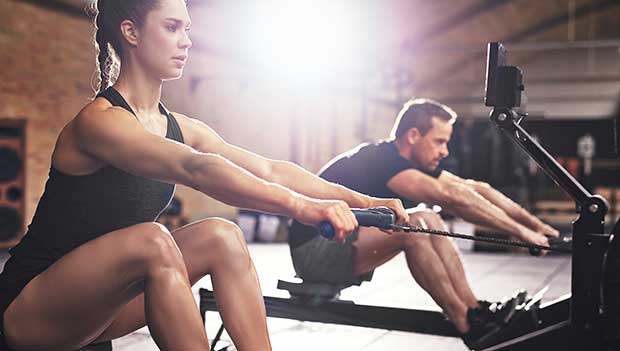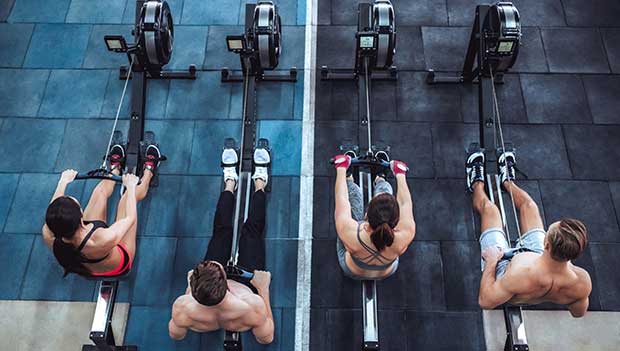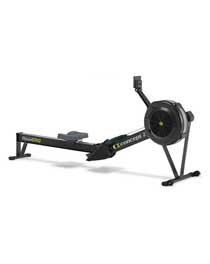
By clicking on the product links in this article, we may receive a commission fee at no cost to you, the reader. Sponsorships and affiliate commissions help support our research so we can help you find the best products. Read our full affiliate disclosure here.
With the ever-increasing popularity of CrossFit, rowing has quickly become more than just a water sport and is now a part of the cardio conversation. These days, you're likely to find a rowing machine in your neighborhood gym. That's because rowing is an excellent full-body workout, especially if you're looking for a gateway to HIIT (high-interval intensity training) or are a runner in need of a new cross-training regimen.
What if you don't have regular gym access? Rowing machines for home use are more accessible than ever, with several models available that cater to your budget, space, and training needs. We asked Célia Dupré—an aspiring Olympian, 2-time world rowing champion, and member of the Stanford Women's and Swiss Rowing teams—how she utilizes these machines when not training on the water, as well as why rowing is such a powerful workout.
Read on for more of the benefits of rowing, how to correctly use a rowing machine, and what to look for when purchasing a rowing machine for your home gym.
Here's Celia's Favorite Rowing Machine:
Our Rowing Machine Recommendations
- Concept 2 Rowerg Rower
- Echelon Row-s Connected Rowing Machine
- Sole Fitness SR500
- NordicTrack RW700 Rower
- Horizon Oxford 6
What is a Rowing Machine?
A rowing machine—sometimes called an indoor rower or ergometer—is a cardio machine made to simulate the motion and effort of rowing on water. There are four types of rowing machines available for home and gym use:
- Air rowers send air through the flywheel and then create tension and resistance based on the amount of force you use to pull the handle. These rowing machines can be smooth but noisy.
- Water rowers are more expensive because they have a built-in water tank that uses flywheel paddles to create drag and resistance when turning through the water. Water rowers are mostly silent—except for the occasional sloshing sound—and are a bit more expensive and high-maintenance, as you will want to clean the basin regularly to prevent mold.
- Magnetic rowers use rotating magnets that create resistance as you pull. These rowing machines tend to have options for adjusting your level of resistance, rather than basing it on how hard or fast you're pulling the handle. Magnetic rowers tend to be more quiet compared to air or water rowers, but can feel the least like legitimate water rowing.
- Hydraulic rowers are smaller than average and create resistance with pistons that are attached to the handles. This is less of a full-body movement since your feet are in a fixed position—depending on the model—and you mostly rely on your arms to generate force. That said, hydraulic rowers are often more budget-friendly and easier to maneuver.
So, what machine does our rowing expert Célia Dupré personally use? "I like to use the air erg because it is the one with the most resistance variation and the one that I was introduced to from the beginning, as well as what the teams I am on use. The grip at the front of the machine builds up well with the air machines," says Dupré.
How Do You Use a Rowing Machine?
Proper rowing machine technique can vary depending on the type of machine that you are using. Once you have customized your machine settings, you'll want to remember the four components of a rowing stroke: catch, drive, finish, and recovery.
- Catch: This is your starting position. You'll want to make sure your back is straight, your upper body is tilted forward but not hunched, your feet are secure, and your knees are bent and close to your chest. Fully extend your arms as you take hold of the handle.
- Drive: Drive backward by pushing off of the footrest with your heels and extending your legs.
- Finish: Using your back muscles, lean back slightly and pull the handle to a finishing position below your ribs while lightly squeezing your shoulder blades together.
- Recovery: Now reverse the first three steps by leaning forward, extending your arms, and bending your knees back to the starting position.
"The best part of the stroke to focus on is the recovery sequence. The rest of the stroke will then come after," says Dupré. "Often, when we see fitness videos of non-rowers rowing, they lift the handle over the knees, but the handle should be past the knees before the knees fold/break. You can do this effectively when the arms and the body are placed forward with the legs fully extended. Then the knees can fold and roll up to the catch, which will make for calmer strokes and will be easier to hold for a long time, as well as an efficient way of building a good drive/push phase." she adds.
Along with using a fluid range of motion, pay close attention to your form so you can get the full benefits of the exercise and avoid injury. A great way to keep yourself in check is by using a rowing app to serve as your guide as you track progress and improve your rowing technique.

Rowing Machine Benefits
There are many great benefits of using a rowing machine for your cardio training, but here are our top 10 reasons you should consider adding rowing to your training regimen. Rowing machines:
- Provide a low-impact cardio workout that is easy on your joints
- Work your full body and help you develop a stronger core
- Burn calories
- Build cardiovascular health
- Can help improve posture
- Are meditative and may help ease anxiety and stress
- Are accessible to all ages and fitness levels
- Offer a more dynamic workout than other cardio machines
- Are efficient and provide an effective workout in as little as 20 minutes
- Are space-savers and can fit easily into home gyms or smaller spaces
How to Pick the Right Rowing Machine
While we've done some of the work for you by providing our research-based rowing machine recommendations above, there are still considerations to keep in mind when choosing the best rowing machine for you.
You’ll need to determine the type of rowing machine, as well as the dimensions, price, and features that work best for your home gym needs. Rowing machines can range from budget-friendly hydraulic rowers to more high-end models like the Echelon E-s that feature a 22-inch HD touchscreen and integrated app.
Additionally, if you're a beginner or are already serious about rowing, you may be interested in a certain level of coaching. A coach can help guide you through your training sessions which may be the motivation required to justify the price tag. At the end of the day, be real with yourself and your needs in order to select a machine that you know you’ll consistently use.
Rowing Machine vs. Other Cardio Machines

Rowing machines are a lot more low-impact than a treadmill or an elliptical. This will come in handy if you need regular cardio exercise, but have issues with joint pain or are recovering from an injury. However, don’t confuse low impact with a low amount of effort. A rowing machine allows you to still reap the calorie-burning benefits of a more high-impact cardio machine without compromising your joints.
If rowing was just a leisurely trip around the lake, it probably wouldn't be featured in so many brutal CrossFit WODs. Additionally, you may lose more weight (that is, pounds on the scale) on a treadmill while a rowing machine can help you exchange your weight loss for muscle gain and overall toning. Fat loss arguably has a greater impact than weight loss alone by improving the way your weight is distributed.
We asked Célia Dupré why she prefers rowing to other forms of cardio. "Rowing is so beautiful; it's so technical compared to sports like running and is more about volume and less about technique. It's a feeling that no other sport can convey. Something that I think no other sport does is sit on the line between endurance and sprinting," she said.
You can follow Célia Dupré's journey to the Olympics and beyond by checking out her website or following her on Instragram @cecece13.
Why Trust Us?
ACTIVE.com’s editorial team relies on the knowledge and experience of fitness and wellness experts including competitive athletes, coaches, physical therapists, nutritionists, and certified trainers. This helps us ensure the products we feature are of the highest standard. Collectively, the team has spent countless hours researching equipment, gear, and recovery tools in order to create the most accurate, authentic content for our readers. Customer satisfaction is also a key part of our review process, which is why we only feature products that are highly rated.
FAQs
Can a rowing machine be used as a full-body workout?
In short, yes! Rowing machines work major muscle groups in your quads, hamstrings, glutes, core, and back, and help build up endurance and strength. You can achieve the fat-burning, muscle-building benefits of an excellent full-body workout in as little as 20 minutes with a rowing machine.
How does using a rowing machine impact cardiovascular health?
A rowing machine can have a positive impact on cardiovascular health because it is a full-body, strength-building exercise. The push-and-pull motion of rowing is an aerobic exercise that builds up endurance and gets your heart pumping, which helps strengthen your cardiovascular system over time.
Is a rowing machine a good option for weight loss?
As with any weight-loss regimen, consistency is key. Rowing incorporates several major muscle groups into a dynamic full-body workout that burns fat and builds muscle and stamina. This form of conditioning helps burn more calories and contributes to weight loss over time. Consistently rowing up to four times per week, for at least 20-30 minutes of high-intensity intervals could have a significant impact on your health and weight loss goals. Your diet and nutrition regimen will play a large part in this as well.
Is it safe for people with back pain to use a rowing machine?
The answer is yes, but only when used correctly. A rowing machine is low-impact and therefore takes some of the pressure off of your back and knees as opposed to other cardio machines. Rowing may even help you to strengthen your back muscles over time. However, if you aren't using the correct rowing form—such as hunching forward when initiating a stroke—you may do more harm to your back than good. Check with your doctor, physical therapist, or personal trainer if you're dealing with back pain and are interested in the benefits of a rowing machine.



